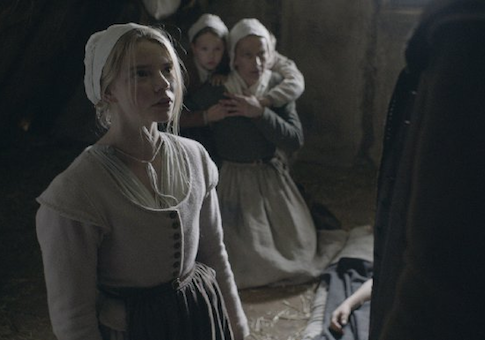The Witch is the rarest of horror films, one that earns its R rating not for explicit violence or gore or bad language or rampant sex (though there is a decent bit of nudity, especially toward the end). Rather, writer/director Robert Eggers expertly ramps up the tension by setting his tale in a familiar-yet-foreign locale and using the natural terror of isolation from society to prompt chills and thrills from audiences.
And this more demure take on the genre makes sense, given that The Witch is set in a New England colony in the 1630s. There’s no place for f-bombs or teenaged sex romps in this land of thous and thees and verilys. But there’s plenty of room for witchcraft, mistrust, and Satan.
William (Ralph Ineson) stands accused of heresy as the film opens. Rather than recant, he chooses to leave the plantation on which he and his family—wife, Katherine (Kate Dickie); oldest daughter, the teenaged Thomasin (Anya Taylor-Joy); younger son Caleb (Harvey Scrimshaw); twins Mercy and Jonas (Ellie Grainger and Lucas Dawson, respectively); and a newborn, Samuel—reside. They gather their belongings and set forth to stake out new ground in the New World.
Life in the homeland was undoubtedly harsh. Their new life is harsher still: we see them briefly one night during their journey outside the town walls. The family huddles next to a fire, its light barely holding the wilderness’ encroaching darkness at bay. They are on their own.
Well.
Not entirely on their own.
The action picks up some time later. The family has built a home and grown some corn, but the crops are sickly and not much worth trading. Still, they struggle on. "We will conquer this wilderness—it shall not consume us," William decrees, suffering mightily from the sin of pride at the expense of his family’s wellbeing. As Katherine shucks the corn, Thomasin takes charge of little Samuel and heads to the edge of their encampment for a game of peekaboo. While hiding her eyes for a moment, the baby vanishes.
We see what happened to the little guy: He’s been snatched up by a mysterious figure fleeing deep into the dark woods. And, though we don’t see it, he’s soon to be turned into witch paste.
But Thomasin does not see this, and neither does her family. Given the Puritanical preoccupation with witchcraft—and the meddlesome, tricky behavior of her twin brother and sister—it’s only a matter of time before suspicion falls upon Thomasin herself. After Caleb suffers his own bewitching at the hands of the she-devil in the woods, the family sets to tearing itself apart. Chaos reigns. And into the vacuum seeps an evil presence.
Eggers makes expert use of the family’s isolation. A two-day ride from the town they’ve fled, the vast openness of the field surrounding the family farm feels almost as claustrophobic as the sky-high trees in the witch’s forest. The camera often lingers on the faces of our heroes, giving us little spatial awareness and emphasizing the fact that danger can emerge from any direction. Meanwhile, the score’s screeching strings and wailing voices allow the viewer few moments of reprieve. The Witch is an almost physically oppressive experience, and I mean that in the nicest way possible.
Ineson’s turn as the prideful father who can do nothing properly—save for chopping and stacking wood—is by turns endearing and enraging, while Dickie’s heartbroken mother gives the film its emotional heft. But the breakout star here is Taylor-Joy, a model whose porcelain skin and eerie good looks help contribute to the film’s otherworldly sensibility.
